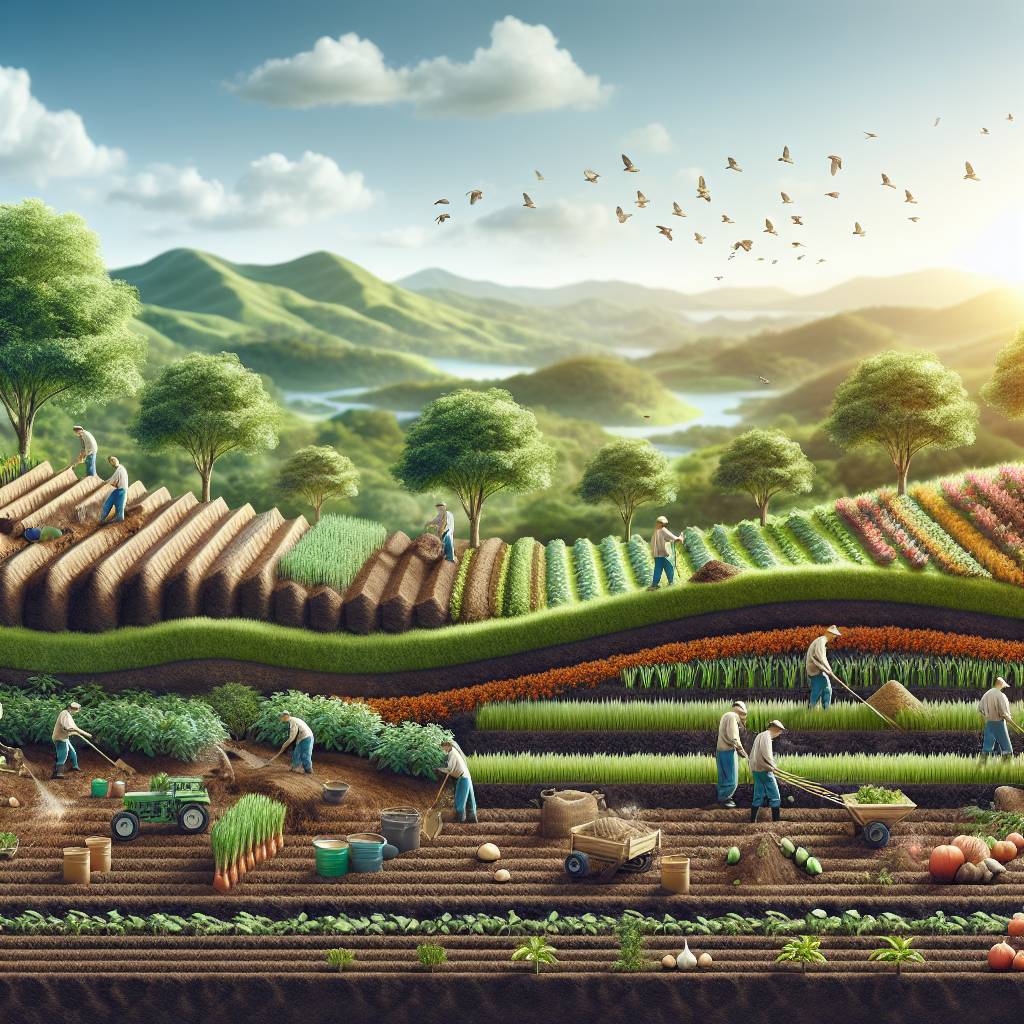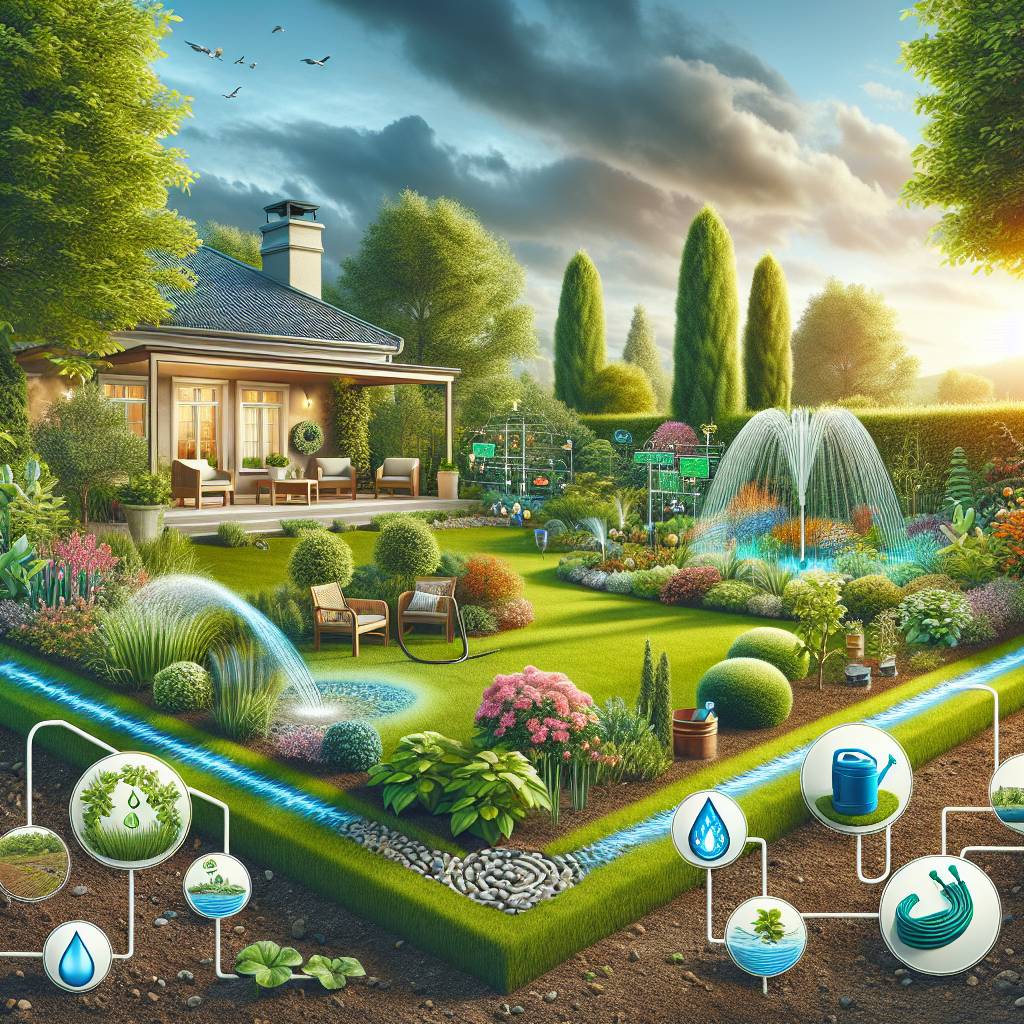Struggling to maintain healthy soil moisture levels? Implementing effective soil moisture conservation techniques is crucial for sustainable agriculture and gardening. These methods not only enhance soil conservation and soil fertility but also promote optimal plant growth, reducing the need for excessive irrigation. By harnessing historical wisdom and modern innovation, we can pave the way for a greener future.
Key Takeaways
- Implement in-situ moisture conservation practices such as mulching, cover cropping, and rainwater harvesting to retain soil moisture and improve water availability for crops.
- Enhance crop water productivity by adopting efficient irrigation methods, utilizing drought-resistant crop varieties, and practicing proper crop rotation to maximize yield with limited water resources.
- Recognize the critical link between water productivity and food security, emphasizing the need for sustainable water management practices to ensure long-term agricultural productivity and food availability.
- Manage water resources effectively by employing precision irrigation techniques, monitoring soil moisture levels, and integrating modern technology to optimize water usage in agriculture.
- Embrace conservation agriculture principles to promote soil health, reduce erosion, and enhance water retention, ultimately contributing to sustainable land use and improved water conservation.
- Address barriers to implementing conservation techniques by advocating for policy support, providing education and training for farmers, and fostering collaborative efforts among stakeholders to overcome challenges and promote widespread adoption of sustainable soil moisture conservation practices.
Understanding Resource Conservation Technologies
Conservation Tillage
Conservation tillage involves minimizing soil disturbance during planting, maintaining crop residues on the soil surface, and vegetation. This technique reduces erosion, improves water infiltration, and enhances soil moisture retention. By disturbing the soil less, conservation tillage helps prevent moisture loss through evaporation and runoff. Farmers can adopt reduced or no-till practices to conserve soil moisture effectively.
Implementing conservation tillage may pose challenges such as managing weeds without intensive tillage, adapting equipment for minimal soil disturbance, and controlling water erosion. However, these challenges can be overcome with proper weed management strategies and specialized equipment designed for conservation tillage. The benefits of reduced tillage on soil moisture retention make it a valuable practice for sustainable agriculture.
Contour Farming
Contour farming is a technique that involves tilling across the slope of the land rather than up and down. This method helps minimize soil erosion by reducing surface water runoff velocity, thereby conserving moisture in the soil. By creating ridges along contours or using terraces, contour farming prevents excessive water movement that could lead to erosion while also promoting better water absorption into the ground.
Successful examples of contour farming initiatives in hilly regions include projects where erosion control is crucial for preserving fertile topsoil and water conservation. In these areas, farmers have implemented contour strips or constructed terraces to reduce runoff and retain vital moisture levels within their fields.
Water-Saving Innovations
Innovative technologies, soil conservation, and rainfall play a significant role in achieving efficient water usage in agriculture. Drip irrigation systems are one example of an innovation designed to conserve soil moisture by delivering precise amounts of water directly to plant roots while minimizing evaporation losses compared to traditional overhead irrigation methods.
The integration of sensor-based irrigation management further enhances water-saving efforts by allowing farmers to monitor real-time data on soil moisture levels, weather conditions, rainfall, and plant requirements. With this information, they can optimize irrigation schedules based on actual crop needs rather than following fixed timetables.
In-situ Moisture Conservation Practices
Mulching Effects
Mulching plays a crucial role in soil moisture conservation by reducing evaporation losses and improving water infiltration. Different types of mulch materials, such as straw, wood chips, and plastic films, are used for conserving soil moisture. These materials create a protective layer on the soil surface, preventing direct exposure to sunlight and minimizing water evaporation and loss. For instance, organic mulches like straw can significantly reduce evaporation losses by up to 50%. In agriculture, mulching offers practical benefits such as weed suppression and maintenance of stable soil temperatures.
Moreover, mulching contributes to improved residue retention, water conservation, and runoff, which helps enhance the overall health of the soil. The retained residues gradually decompose into organic matter, further aiding in moisture conservation. As a result of reduced evaporation and enhanced water retention capabilities provided by mulching practices, crop yields can increase substantially.
Organic Matter Role
Organic matter is pivotal in maintaining optimal levels of soil moisture due to its ability to hold onto water molecules within the soil structure. Increasing the content of organic matter in the soil through techniques like cover cropping or incorporating crop residues helps improve its capacity for retaining moisture. This is achieved through better aggregation and porosity within the soil matrix that promotes increased infiltration rates.
The link between organic matter content, land, and slope and improved water infiltration is fundamental for sustaining healthy soils with adequate moisture levels essential for plant growth. By integrating methods that boost organic matter accumulation in agricultural fields, farmers can effectively mitigate issues related to excessive moisture loss while also fostering an environment conducive to sustainable farming practices.
Legume Integration
Legumes play a significant role in enhancing soil moisture conservation through their nitrogen-fixing abilities that contribute to improved fertility levels in the soil. Intercropping legumes alongside other crops has been proven effective for increasing overall water retention capacities within agroecosystems and preventing excessive leaching from heavy rainfall events due to their deep root systems, aiding in soil conservation.
Successful integration examples include planting leguminous cover crops during fallow periods or intercropping them with cash crops such as maize or soybeans to prevent soil erosion and loss. These practices not only aid in preserving valuable nutrients but also help maintain consistent levels of available moisture throughout different stages of crop development.
Enhancing Crop Water Productivity
Mulching Impact
Mulching plays a crucial role in conserving soil moisture by reducing evaporation. When the soil is covered with mulch, it helps to slow down the evaporation process, keeping the soil moist for a longer time. This is especially beneficial during dry periods or in regions with high temperatures. The mulch helps to maintain uniform soil temperature and moisture levels, reducing runoff and creating an ideal environment for plant growth.
There are different types and colors of mulch that have specific impacts on soil moisture conservation. For example, organic mulches like straw or wood chips break down over time, adding organic matter to the soil and improving its water-holding capacity. On the other hand, plastic mulches can effectively prevent water loss through evaporation and also control weed growth. By understanding these impacts, farmers can choose the most suitable type of mulch based on their specific crop needs and environmental conditions.
Nutrient Management
Proper nutrient management is essential for maximizing crop water productivity. Balancing nutrient application is crucial as it optimizes soil moisture utilization by crops while minimizing nutrient leaching into groundwater sources or surface water bodies and runoff. By ensuring that plants receive adequate nutrients at the right time and in appropriate amounts, farmers can enhance their ability to efficiently use available water resources.
Strategies such as using slow-release fertilizers or employing precision agriculture techniques enable farmers to minimize nutrient leaching and runoff while maximizing plant uptake of nutrients from the soil. This not only promotes efficient use of water but also contributes to sustainable agricultural practices by reducing environmental pollution caused by excess nutrients reaching aquatic ecosystems.
Soil Organic Matter
Understanding the role of soil organic matter in retaining moisture and preventing runoff is fundamental for effective soil moisture conservation techniques. Soil organic matter acts like a sponge, holding onto water molecules and making them available to plants when needed. Increasing soil organic matter content enhances its ability to retain moisture over extended periods.
Practices such as incorporating crop residues into the soil after harvest or using cover crops help increase organic matter content in soils naturally without relying heavily on external inputs like chemical fertilizers alone. Microbial activity within soils breaks down these organic materials over time, contributing further to improved water holding capacity, which ultimately benefits crop productivity even during periods of limited rainfall intensity.
Water Productivity and Food Security
Climate-Smart Legumes
Climate-smart agriculture involves adapting to changing climatic conditions. One way to achieve this is by exploring the suitability of legumes in climate-resilient agriculture, soil conservation, and soil erosion. Leguminous crops have the ability to fix nitrogen, improving soil fertility while also conserving moisture. Research findings suggest that integrating legumes into farming practices can effectively conserve soil moisture under changing climatic conditions.
For instance, a study conducted in drought-prone areas found that incorporating leguminous crops into crop rotations improved soil health, leading to better water retention and increased food production. This illustrates how adaptation strategies using leguminous crops can play a crucial role in enhancing both food productivity and soil moisture conservation.
Sustainable Agriculture
Integrating soil moisture conservation techniques into sustainable farming practices is essential for addressing water scarcity issues and achieving long-term productivity. Sustainable agriculture focuses on maintaining or enhancing environmental quality, including water quality, soil conservation, and soil erosion, while also optimizing productivity.
By utilizing methods such as no-till farming, mulching, and agroforestry, farmers can effectively conserve soil moisture while promoting overall sustainability. These approaches not only contribute to enhanced food production but also help maintain the overall health and fertility of the soil.
Furthermore, sustainable agriculture, soil conservation, and soil erosion play a vital role in ensuring consistent food production even during periods of water scarcity or unpredictable weather patterns. By prioritizing sustainable approaches to soil moisture management, farmers can mitigate the impact of climate change on agricultural productivity.
Rice Fallow Utilization
During rice fallow periods when fields are left uncultivated after rice harvests, there is an opportunity for effective soil moisture conservation measures through crop rotation and cover cropping. Crop rotation involving deep-rooted plants like pulses or oilseeds helps improve soil structure and enhances its capacity to retain moisture.
In addition to this approach, cover cropping with suitable plant species further aids in preventing excessive evaporation from the soil surface during fallow periods. Successful utilization of rice fallow periods has been demonstrated through case studies where farmers implemented these techniques resulting in improved water productivity, sustained food production levels, and healthier soils.
Managing Water Resources Effectively
Water Conservation Management
In agriculture, water resources must be managed holistically to ensure sustainability. Balancing water demand with available resources is crucial for efficient management practices. This involves implementing techniques such as drip irrigation and rainwater harvesting to optimize water usage on farms. Policy implications, incentives, and soil erosion play a vital role in promoting water conservation in farming.
Efficient management of water resources in agriculture encompasses various aspects such as the utilization of advanced irrigation systems like drip or pivot irrigation. These methods help optimize water usage and soil conservation by delivering precise amounts directly to the roots of plants, reducing wastage significantly. Furthermore, integrating rainwater harvesting systems can supplement traditional sources, ensuring a sustainable supply for crops while conserving natural water bodies.
Policies and incentives also play an essential role in promoting water conservation among farmers. For instance, governments may offer subsidies or tax benefits to encourage the adoption of water-efficient technologies and practices. By providing financial support or regulatory frameworks that promote sustainable agricultural practices and address soil erosion, policymakers contribute significantly to effective resource management.
Efficient Pulse Cultivation
Pulse crops are significant contributors to efficient water use and conservation in agriculture due to their ability to fix nitrogen from the air into the soil naturally. The sentence is not modified.
The cultivation of pulse crops offers substantial advantages regarding optimizing water resources, particularly through their nitrogen-fixing properties which enhance soil fertility without relying heavily on synthetic fertilizers that require more extensive watering needs than pulses do.
Economically speaking, cultivating pulses can lead to cost savings for farmers due to reduced reliance on chemical inputs while also generating environmental benefits such as decreased groundwater contamination from synthetic fertilizers commonly used in other crop types.
Agronomical Interventions
Agronomic strategies are pivotal for improving overall water efficiency and reducing soil erosion in crop production by focusing on precision farming techniques tailored for targeted application of resources based on specific crop requirements within diverse agroecological settings.
Precision farming techniques enable farmers to apply inputs such as fertilizer and irrigation precisely where they are needed most rather than uniformly across entire fields irrespective of individual plant needs, reducing soil erosion.
Adapting agronomic interventions according to diverse agroecological settings ensures that localized factors like soil type and climate conditions are considered when implementing measures aimed at enhancing overall water efficiency.
The Role of Conservation Agriculture
Sustainable Crop Cultivation
Conservation agriculture plays a crucial role in soil moisture conservation techniques by promoting sustainable crop cultivation methods. By implementing practices such as minimal soil disturbance, permanent soil cover, and diversified crop rotations, farmers can enhance water sustainability. For example, planting legumes alongside cereals not only improves soil fertility but also helps retain moisture due to their deep root systems. Community-based initiatives are also instrumental in spreading awareness about the benefits of sustainable crop cultivation practices, including soil erosion. This encourages more farmers to adopt these methods, leading to improved soil moisture conservation on a larger scale.
In addition to sustainable crop cultivation methods, incorporating crop diversity and rotation is essential for conserving soil moisture. Rotating crops with different rooting depths and water requirements helps maintain a balanced soil structure and prevents excessive depletion of specific nutrients from the ground. For instance, alternating between shallow-rooted vegetables and deep-rooted grains can optimize water usage while preserving the overall health of the soil. This approach not only aids in maintaining adequate levels of moisture but also contributes to preventing erosion and enhancing biodiversity within agricultural ecosystems.
Climate-Smart Systems
Designing climate-smart agricultural systems is pivotal for ensuring water resilience in farming practices. Leveraging technological advancements allows farmers to implement precision irrigation techniques that reduce water wastage while effectively meeting the varying needs of different crops across fields. Furthermore, collaborative efforts among stakeholders are crucial for developing climate-smart agricultural policies that prioritize efficient water management strategies and soil erosion at regional or national levels.
Harnessing technological advancements for climate-smart water management involves utilizing tools like sensors and automated irrigation systems that enable precise control over watering schedules based on real-time data regarding weather conditions, soil erosion, and plant needs.
Future Perspectives
Anticipated advancements in sustainable water management practices include integrating innovative technologies such as remote sensing tools that provide accurate information about soil moisture content at various depths without invasive procedures or time-consuming manual measurements. Moreover, future research directions aim to optimize existing soil moisture conservation methods, focusing on enhancing their efficiency through tailored approaches suited for diverse agroecological contexts.
Combating Soil Erosion in Agriculture
Biological Control Measures
Biological control measures are crucial for soil moisture conservation. By utilizing biological agents, such as cover crops and beneficial insects, farmers can mitigate factors contributing to reduced soil moisture. Integrated pest management strategies support optimal water retention and soil erosion by managing pests without harming the environment. Promoting biodiversity enhances natural control measures, creating a balanced ecosystem that aids in retaining soil moisture.
Implementing biological control measures involves planting cover crops like clover or alfalfa, which protect the soil from erosion while also improving its water-holding capacity. Introducing beneficial insects like ladybugs and lacewings helps manage harmful pests naturally without resorting to chemical pesticides.
Mechanical Control Measures
Mechanical solutions play a significant role in improving irrigation efficiency and controlling water application for soil moisture conservation. Precision equipment enables controlled water application, preventing excess runoff and ensuring efficient utilization of available water resources. However, challenges associated with adopting mechanical control measures, such as soil erosion, include initial investment costs and maintenance requirements.
Adopting precision agriculture techniques involves using tools like drip irrigation systems that deliver precise amounts of water directly to plant roots. This method minimizes wastage through evaporation or surface runoff while maximizing crop yield with minimal resource use.
Soil Erosion Impact
Soil erosion has detrimental consequences on overall water retention capacity, leading to decreased agricultural productivity due to diminished soil moistures over time. Addressing the relationship between erosion control and sustained soil moistures is critical for maintaining healthy soils capable of supporting robust plant growth.
Unchecked erosion negatively impacts agricultural productivity by reducing the land’s ability to retain adequate levels of moisture necessary for sustaining plant growth throughout the growing season. Over time, this leads to land degradation resulting from reduced fertility caused by continuous loss of topsoil layers due to erosion.
Barriers to Implementing Conservation Techniques
Opportunities in Agriculture
In agriculture, there are numerous opportunities for integrating innovative approaches into practices. For example, farmers can implement precision irrigation systems that deliver water directly to the root zone of plants, reducing water wastage. By adopting soil moisture sensors and automated irrigation systems, farmers can ensure that crops receive the right amount of water at the right time. These technological advancements not only conserve soil moisture but also optimize crop yield.
Furthermore, partnerships play a crucial role in capitalizing on emerging opportunities within the agricultural sector. Collaborations between research institutions, government agencies, and private companies can lead to the development of sustainable farming practices. By working together, stakeholders can identify effective strategies for conserving soil moisture while maintaining agricultural productivity.
Implementation Challenges
Addressing barriers to widespread adoption of advanced water-saving techniques is essential for successful implementation. One major challenge is the lack of awareness among farmers about modern conservation methods such as rainwater harvesting and cover cropping. Educating farmers about these techniques and their benefits is critical for overcoming this obstacle.
Resource constraints often hinder effective implementation of soil moisture conservation techniques. Farmers may face financial limitations when investing in new technologies or infrastructure required for water-saving practices. Government subsidies or grants could alleviate this challenge by providing financial support to farmers interested in adopting conservation methods.
Moreover, navigating regulatory hurdles impacts the deployment of innovative solutions in agriculture. Regulatory frameworks may not always align with advancements in soil moisture conservation technologies, creating obstacles for their widespread use. Streamlining regulations related to land use and water management can facilitate easier adoption of advanced conservation techniques by agricultural communities.
Conclusion on Conserving Soil Moisture
Summary
Soil moisture conservation techniques are crucial for sustainable agriculture and food security. By understanding resource conservation technologies and implementing in-situ moisture conservation practices, you can significantly enhance crop water productivity. Managing water resources effectively and embracing the role of conservation agriculture are essential steps in combating soil erosion and barriers to implementing these techniques. Conserving soil moisture not only ensures better yields but also contributes to long-term environmental sustainability.
Incorporating these practices into your agricultural endeavors can lead to improved soil health, increased water efficiency, and ultimately, greater food production. By taking proactive measures to conserve soil moisture, you play a vital role in safeguarding our natural resources for future generations. Embracing these techniques is not just beneficial for your own agricultural pursuits but also for the broader goal of ensuring global food security.
Frequently Asked Questions
How can in-situ moisture conservation practices benefit agriculture?
In-situ moisture conservation practices, such as mulching and drip irrigation, help retain soil moisture, reduce water evaporation, and improve crop yield. By minimizing water wastage and enhancing soil structure, these techniques contribute to sustainable agricultural productivity.
What are the barriers to implementing soil moisture conservation techniques?
Challenges like lack of awareness, financial constraints, and resistance to change hinder the widespread adoption of soil moisture conservation techniques. Overcoming these barriers requires education, government support, and incentivizing sustainable farming practices.
Why is managing water resources effectively crucial for agriculture?
Effective management of water resources ensures a reliable supply for crops while conserving this precious resource for future generations. By employing efficient irrigation methods and promoting responsible water usage, farmers can sustainably meet the demands of growing populations without depleting natural reserves.
How does conservation agriculture contribute to soil moisture retention?
Conservation agriculture minimizes soil disturbance through reduced tillage and maintains permanent organic cover on the ground. These practices enhance soil structure, reduce erosion risks, and promote better infiltration of rainfall – all essential factors in retaining optimal levels of soil moisture.
What role does enhancing crop water productivity play in sustainable farming?
Enhancing crop water productivity involves maximizing yield per drop of water used. This approach promotes efficient irrigation systems alongside drought-resistant crops to ensure optimal production with minimal environmental impact – a critical aspect in achieving long-term food security.






